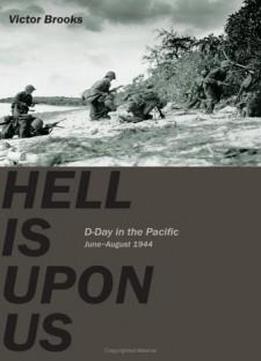
Hell Is Upon Us: D-day In The Pacific--saipan To Guam, June-august 1944
by Victor Brooks /
2005 / English / PDF
38.2 MB Download
June 14, 1944, just nine days after the D-Day invasion of
Normandy, another mighty fleet steamed towards its own D-Day
landing. A huge U.S. flotilla of 800 ships carrying 162,000 men
was about to attempt to smash into the outer defenses of the
Japanese Empire. Their target was the Marianas Island group,
which included Saipan, home to an important Japanese base and a
large population of Japanese civilians, and Guam, the first
American territory captured in the aftermath of Pearl Harbor.
During the next eight weeks, tens of thousands of men, hundreds
of airplanes, and dozens of major warships were locked in mortal
combat. When it was over, 60,000 Japanese ground troops and most
of the carrier air power of the Imperial Navy were annihilated;
Japan's leader, Tojo, was thrown out of office in disgrace; and
the newly captured enemy airfields were being transformed into
launching bases for the B-29s that would carry the conventional
and, later, atomic bombs to Japan, turning the land of the Rising
Sun into a charred cinder. After the U.S. victory in the Marianas
campaign, the road to Tokyo was clearly in sight.
June 14, 1944, just nine days after the D-Day invasion of
Normandy, another mighty fleet steamed towards its own D-Day
landing. A huge U.S. flotilla of 800 ships carrying 162,000 men
was about to attempt to smash into the outer defenses of the
Japanese Empire. Their target was the Marianas Island group,
which included Saipan, home to an important Japanese base and a
large population of Japanese civilians, and Guam, the first
American territory captured in the aftermath of Pearl Harbor.
During the next eight weeks, tens of thousands of men, hundreds
of airplanes, and dozens of major warships were locked in mortal
combat. When it was over, 60,000 Japanese ground troops and most
of the carrier air power of the Imperial Navy were annihilated;
Japan's leader, Tojo, was thrown out of office in disgrace; and
the newly captured enemy airfields were being transformed into
launching bases for the B-29s that would carry the conventional
and, later, atomic bombs to Japan, turning the land of the Rising
Sun into a charred cinder. After the U.S. victory in the Marianas
campaign, the road to Tokyo was clearly in sight.











